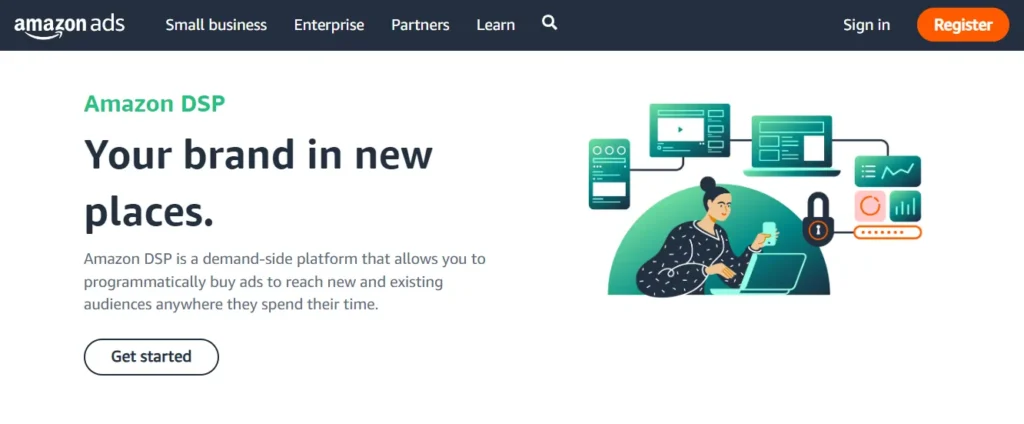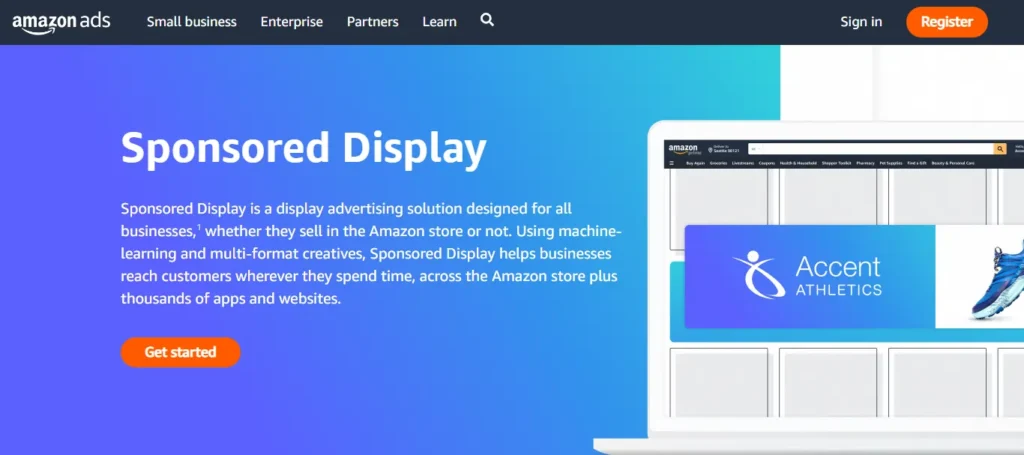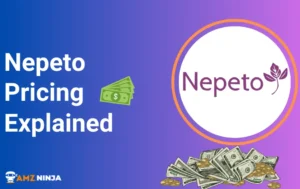
You're probably familiar with Amazon's sponsored ads that appear on product pages and search results. But have you heard about their other advertising options like Sponsored Display and DSP (Demand Side Platform)?
These allow you to reach customers beyond just Amazon's website.
Pretty cool, right?
But what's the difference between these two ad types? Which one is better suited for your business goals?
Ready to break down the key distinctions between Amazon DSP vs Display ads. From eligibility requirements and cost structures to creative control and audience targeting capabilities, we'll cover it all.
Amazon DSP vs Display Ads
The digital advertising landscape on Amazon offers a variety of tools for sellers to promote their products. Two prominent options are Amazon's Demand Side Platform (DSP) and Sponsored Display ads. Let's have a quick comparison between them:
| Feature | Amazon Sponsored Ads | Amazon Display Ads |
|---|---|---|
| Ad Types | Sponsored Products, Sponsored Brands | Sponsored Display |
| Pricing Model | Cost-per-click (CPC) | Cost-per-click (CPC) or Cost-per-thousand viewable impressions (vCPM) |
| Targeting | Keyword or ASIN targeting | Audience or interest-based targeting, product targeting |
| Placements | Amazon search results, product detail pages | Amazon sites, third-party sites/apps, devices like Fire TV |
| Linking | Link to Amazon product detail page | Link to Amazon product page or external website |
| Eligibility | Professional sellers, vendors, agencies | Brand registered sellers, vendors, agencies |
| Minimum Budget | $1 per day | $1 per day (no minimum for some countries) |
| Ad Creative | Basic product/brand ad | Customizable display banners or auto ads |
| Purpose | Promote individual products, increase sales | Build awareness, retarget viewers, promote catalog |
Amazon DSP and Sponsored Display serve different purposes and come with their own sets of features. While both platforms can help increase product visibility, they cater to varying advertising needs and levels of complexity.
Amazon DSP is a demand-side platform that enables advertisers to buy display ads programmatically across the web, not just limited to Amazon's marketplace. This platform is ideal for advertisers who wish to reach a broader audience and have more sophisticated advertising goals. It is particularly suitable for brands that may not sell directly on Amazon, as it allows for traffic to be directed to external websites.
On the flip side, Sponsored Display is a self-service advertising solution that is more retail-centric, focusing primarily on advertising within the Amazon ecosystem. It's designed for simplicity and ease of use, making it accessible to a wide range of advertisers, including those who are new to Amazon advertising.
Targeting Capabilities Comparison
| Feature | Amazon DSP | Sponsored Display |
|---|---|---|
| Platform Type | Programmatic advertising across the web | Self-service within Amazon |
| Accessibility | Suitable for sophisticated advertisers | Accessible to a wide range of advertisers |
| External Traffic | Can direct to external sites | Restricted to Amazon platform |
| Targeting Options | Advanced, including custom audiences | Streamlined, focused on Amazon interactions |
When it comes to targeting capabilities, Amazon DSP stands out for its advanced options. It allows advertisers to create highly targeted ads by utilizing Amazon's rich customer data, including search and purchasing history, as well as engagement with other Amazon platforms like Prime Video. This enables advertisers to reach specific audiences with tailored messages.
Amazon DSP's targeting options are more granular and diverse, offering demographics, lifestyle, purchase intent, remarketing, and lookalike audiences. Advertisers can also create custom audiences based on Amazon's extensive data, ensuring that their ads are shown to the most relevant consumers. Additionally, DSP provides brand protection tools to maintain ad relevancy and safeguard brand image.
In contrast, Sponsored Display provides a more streamlined approach to targeting, focusing on shoppers who have previously interacted with your products or similar items on Amazon. While it may not offer the same level of detailed targeting as DSP, it is a powerful tool for driving conversions and retaining visibility within the Amazon marketplace.
Considering the core differences in targeting capabilities between Amazon DSP and Sponsored Display can assist sellers in selecting the right tool for their goals.
- For a broader reach and more intricate campaign management, Amazon DSP may be the best choice.
- For those focusing on the Amazon marketplace with a preference for simpler campaign management, Sponsored Display could be the ideal solution.
Benefits of Amazon DSP

Amazon Demand-Side Platform (DSP) offers a sophisticated advertising solution for sellers and brands aiming to reach a wider audience and achieve more refined targeting. Here we’ll explore the advantages of Amazon DSP in terms of audience reach and targeting options.
1. Advanced Audience Reach
Amazon DSP is a powerful tool for advertisers seeking to expand their reach beyond the confines of the Amazon marketplace. With access to Amazon's extensive network, advertisers can deliver their ads across numerous platforms and devices, reaching potential customers on other websites, apps, and even through streaming video services.
One of the most notable features of Amazon DSP is the ability to create Over-the-Top (OTT) video ads. These non-skippable ads are displayed before, during, or after streaming content, capturing the attention of viewers who are increasingly consuming digital video content.
Additionally, Amazon DSP offers Online Video ads (OLV), which are skippable but have the added functionality of being clickable. These ads can direct customers to a product detail page or a company's website, offering a direct path to purchase or more information.
Through Amazon DSP, advertisers can not only reach Amazon shoppers but also leverage the platform's data to target audiences across the web who have shown similar behaviors to their existing customers. This level of reach is particularly beneficial for brands that are looking to scale their advertising efforts and make a significant impact.
2. Precise Targeting Options
The targeting capabilities of Amazon DSP are where the platform truly shines. Unlike Sponsored Display, Amazon DSP provides a lot of targeting options that serve a variety of advertising strategies. Advertisers can select from demographics, lifestyle segments, purchase intent, remarketing, and lookalike audiences.
Moreover, Amazon DSP utilizes the wealth of Amazon's customer search and purchasing history, along with data from other Amazon-owned platforms like Prime Video. This enables advertisers to craft highly targeted ads that are delivered to consumers at various stages of their buying journey, from awareness to consideration to purchase.
To ensure that ads are relevant and placed within suitable content, Amazon DSP also provides brand protection tools. These tools give advertisers control over the context in which their ads appear, ensuring alignment with brand values and messaging.
The comparison table below highlights the key targeting options available through Amazon DSP:
| Targeting Capability | Description |
|---|---|
| Demographics | Target based on age, gender, income, etc. |
| Lifestyle | Reach customers with specific interests and habits. |
| Purchase Intent | Engage shoppers who have shown interest in similar products. |
| Remarketing | Reconnect with users who have previously interacted with your brand. |
| Lookalike Audiences | Find new customers similar to your existing customer base. |
Advantages of Sponsored Display

When it comes to advertising on Amazon, Sponsored Display Ads offers distinct advantages, particularly for those who value straightforward campaign management and a concentrated focus on the Amazon shopping environment. These benefits are tailored to enhance the experience for Amazon Sellers who aim to leverage the platform's vast user base and data.
1. Simplified Campaign Management
Sponsored Display is celebrated for its user-friendly campaign setup and management. This self-service display advertising solution is accessible to vendors and professional sellers enrolled in the Amazon Brand Registry. It is engineered for simplicity, allowing sellers to create and oversee their campaigns without the need for extensive marketing expertise or resources.
The interface provided is intuitive, making it possible for sellers to quickly launch campaigns with a few clicks. Advertising on Amazon through Sponsored Display does not require a large budget or the ability to produce custom ad creatives, which can be a significant barrier for smaller sellers or those new to digital advertising. The ease of use is a considerable advantage for sellers who prefer to manage their advertising efforts directly and efficiently.
2. Focus on the Amazon Ecosystem
Sponsored Display ads are designed to keep the advertising experience within the confines of the Amazon ecosystem. This focus ensures that the ads reach customers who are already engaged in the shopping process on Amazon, which can lead to higher conversion rates. By targeting shoppers who search for relevant products, view similar items, or have previously made purchases from the seller's brand, Sponsored Display ads drive awareness and sales directly where it matters most.
Moreover, these ads can appear both on and off Amazon, expanding the reach yet keeping the core focus on users likely to be interested in purchasing on the platform. This dual presence ensures that brands stay top of mind for customers throughout their buying journey. The integration with the Amazon ecosystem presents a strategic benefit for sellers looking to capitalize on the platform's extensive user base and data insights.
Sponsored Display ads can be purchased on a cost-per-click (CPC) or cost-per-1,000 viewable impression basis (vCPM), providing sellers with flexible pricing options to suit their budget and advertising goals.
For sellers considering other platforms, it can be useful to compare Shopify vs Amazon FBA and evaluate differences between Amazon FBA Wholesale vs Private Label.
Cost and Entry Requirements
For Amazon sellers and online retailers, understanding the financial implications of advertising platforms is key to making informed decisions. In this section, we compare the costs and entry requirements for Amazon DSP (Demand-Side Platform) and Sponsored Display ads.
1. Financial Considerations
Sponsored Display ads and Amazon DSP both offer different cost structures and financial commitments, making it essential for sellers to choose the right option based on their advertising goals and budget constraints.
Sponsored Display ads allow sellers to opt for a cost-per-click (CPC) or cost-per-thousand impressions (CPM) structure. This flexibility enables sellers to align their payment model with their marketing objectives, whether that's increasing brand visibility or driving immediate sales.
Amazon DSP, however, operates on a CPM basis. This model charges advertisers based on the number of impressions their ads receive, rather than clicks. While this can be beneficial for brand awareness campaigns, it requires careful budget management to ensure a positive return on investment.
2. Minimum Budget Comparison
When it comes to minimum budget requirements, there's a significant difference between Sponsored Display ads and Amazon DSP.
| Advertising Platform | Minimum Spend |
|---|---|
| Sponsored Display Ads | $1 per day |
| Amazon DSP (Self-Service) | $10,000 per month |
| Amazon DSP (Managed Service) | $35,000 – $50,000 per month |
As indicated in the table, Sponsored Display ads present a low barrier to entry, with a minimum spend of just $1 per day. This makes it an accessible option for brands with a limited advertising budget or those just starting out on Amazon.
On the other hand, Amazon DSP requires a higher investment. The self-service option requires a minimum monthly spend of $10,000, while Amazon Managed Services DSP needs a minimum of $35,000 to $50,000 monthly spend. This higher threshold may be more suitable for established brands or those with a significant advertising budget. For a deeper understanding of Amazon's selling models, explore Amazon FBA Wholesale vs Private Label.
Common Queries Related to Amazon DSP and Display Ads
What are Sponsored Display Ads?
Sponsored Display Ads are self-service display ads that allow Amazon sellers to advertise their products on and off Amazon's websites/apps.
What's the Pricing Model for DSP Ads?
Amazon DSP ads use a CPM (cost per thousand impressions) pricing model.
What's the Minimum Investment for Amazon DSP?
For managed service, a $50,000 minimum monthly spend. For self-service, $6,000-$10,000 per month is recommended.
Where do Sponsored Display Ads Appear?
On Amazon sites, third-party apps/websites, and across devices like Fire TV.
Who Can Use Amazon DSP?
Both Amazon sellers and businesses that don't sell on Amazon can use Amazon DSP to reach Amazon's audience.
Final Showdown
Alright, let's wrap this up in a nice little bow. Choosing between Amazon DSP and Sponsored Display ads comes down to your specific goals and resources.
If you're a brand that doesn't sell on Amazon but wants to tap into its massive audience, DSP is the way to go – just be ready to pony up that minimum $35k investment.
But if you're an Amazon seller looking for a more cost-effective option to drive traffic to your listings, Sponsored Display is a no-brainer with its low $1 entry point.
Either way, you've got options to get your products in front of the right eyeballs. So do your homework, pick the ad type that vibes with your business, and get ready to see those sales numbers climb!
Any other questions? Drop a comment below 💬







